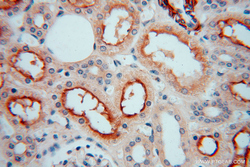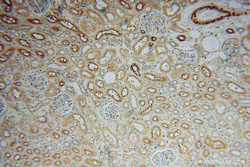Antibody data
- Antibody Data
- Antigen structure
- References [10]
- Comments [0]
- Validations
- Western blot [1]
- Immunohistochemistry [2]
Submit
Validation data
Reference
Comment
Report error
- Product number
- 16094-1-AP - Provider product page

- Provider
- Proteintech Group
- Proper citation
- Proteintech Cat#16094-1-AP, RRID:AB_2134007
- Product name
- KPTN antibody
- Antibody type
- Polyclonal
- Description
- KD/KO validated KPTN antibody (Cat. #16094-1-AP) is a rabbit polyclonal antibody that shows reactivity with human, mouse, rat and has been validated for the following applications: IF, IHC, WB, ELISA.
- Reactivity
- Human, Mouse, Rat
- Host
- Rabbit
- Conjugate
- Unconjugated
- Isotype
- IgG
- Vial size
- 20ul, 150ul
Submitted references Genome-wide CRISPR screens identify ILF3 as a mediator of mTORC1-dependent amino acid sensing.
VWCE modulates amino acid-dependent mTOR signaling and coordinates with KICSTOR to recruit GATOR1 to the lysosomes.
CDK5-PRMT1-WDR24 signaling cascade promotes mTORC1 signaling and tumor growth.
Lysosomal GPCR-like protein LYCHOS signals cholesterol sufficiency to mTORC1.
Structure of the nutrient-sensing hub GATOR2.
The SZT2 Interactome Unravels New Functions of the KICSTOR Complex.
Dihydroxyacetone phosphate signals glucose availability to mTORC1.
Arg-78 of Nprl2 catalyzes GATOR1-stimulated GTP hydrolysis by the Rag GTPases.
Architecture of the human GATOR1 and GATOR1-Rag GTPases complexes.
KICSTOR recruits GATOR1 to the lysosome and is necessary for nutrients to regulate mTORC1.
Yan G, Yang J, Li W, Guo A, Guan J, Liu Y
Nature cell biology 2023 May;25(5):754-764
Nature cell biology 2023 May;25(5):754-764
VWCE modulates amino acid-dependent mTOR signaling and coordinates with KICSTOR to recruit GATOR1 to the lysosomes.
Zhao T, Guan Y, Xu C, Wang D, Guan J, Liu Y
Nature communications 2023 Dec 20;14(1):8464
Nature communications 2023 Dec 20;14(1):8464
CDK5-PRMT1-WDR24 signaling cascade promotes mTORC1 signaling and tumor growth.
Yin S, Liu L, Ball LE, Wang Y, Bedford MT, Duncan SA, Wang H, Gan W
Cell reports 2023 Apr 25;42(4):112316
Cell reports 2023 Apr 25;42(4):112316
Lysosomal GPCR-like protein LYCHOS signals cholesterol sufficiency to mTORC1.
Shin HR, Citron YR, Wang L, Tribouillard L, Goul CS, Stipp R, Sugasawa Y, Jain A, Samson N, Lim CY, Davis OB, Castaneda-Carpio D, Qian M, Nomura DK, Perera RM, Park E, Covey DF, Laplante M, Evers AS, Zoncu R
Science (New York, N.Y.) 2022 Sep 16;377(6612):1290-1298
Science (New York, N.Y.) 2022 Sep 16;377(6612):1290-1298
Structure of the nutrient-sensing hub GATOR2.
Valenstein ML, Rogala KB, Lalgudi PV, Brignole EJ, Gu X, Saxton RA, Chantranupong L, Kolibius J, Quast JP, Sabatini DM
Nature 2022 Jul;607(7919):610-616
Nature 2022 Jul;607(7919):610-616
The SZT2 Interactome Unravels New Functions of the KICSTOR Complex.
Cattelani C, Lesiak D, Liebscher G, Singer II, Stasyk T, Wallnöfer MH, Heberle AM, Corti C, Hess MW, Pfaller K, Kwiatkowski M, Pramstaller PP, Hicks AA, Thedieck K, Müller T, Huber LA, Eca Guimaraes de Araujo M
Cells 2021 Oct 9;10(10)
Cells 2021 Oct 9;10(10)
Dihydroxyacetone phosphate signals glucose availability to mTORC1.
Orozco JM, Krawczyk PA, Scaria SM, Cangelosi AL, Chan SH, Kunchok T, Lewis CA, Sabatini DM
Nature metabolism 2020 Sep;2(9):893-901
Nature metabolism 2020 Sep;2(9):893-901
Arg-78 of Nprl2 catalyzes GATOR1-stimulated GTP hydrolysis by the Rag GTPases.
Shen K, Valenstein ML, Gu X, Sabatini DM
The Journal of biological chemistry 2019 Feb 22;294(8):2970-2975
The Journal of biological chemistry 2019 Feb 22;294(8):2970-2975
Architecture of the human GATOR1 and GATOR1-Rag GTPases complexes.
Shen K, Huang RK, Brignole EJ, Condon KJ, Valenstein ML, Chantranupong L, Bomaliyamu A, Choe A, Hong C, Yu Z, Sabatini DM
Nature 2018 Apr 5;556(7699):64-69
Nature 2018 Apr 5;556(7699):64-69
KICSTOR recruits GATOR1 to the lysosome and is necessary for nutrients to regulate mTORC1.
Wolfson RL, Chantranupong L, Wyant GA, Gu X, Orozco JM, Shen K, Condon KJ, Petri S, Kedir J, Scaria SM, Abu-Remaileh M, Frankel WN, Sabatini DM
Nature 2017 Mar 16;543(7645):438-442
Nature 2017 Mar 16;543(7645):438-442
No comments: Submit comment
Supportive validation
- Submitted by
- Proteintech Group (provider)
- Main image

- Experimental details
- HeLa cells were subjected to SDS PAGE followed by western blot with 16094-1-AP(KPTN antibody) at dilution of 1:400
- Sample type
- cell line
Supportive validation
Supportive validation
- Submitted by
- Proteintech Group (provider)
- Main image

- Experimental details
- The KPTN antibody from Proteintech is a rabbit polyclonal antibody to a recombinant protein of human KPTN. This antibody recognizes human, mouse, rat antigen. The KPTN antibody has been validated for the following applications: ELISA, WB, IHC analysis.
Supportive validation
- Submitted by
- Proteintech Group (provider)
- Main image

- Experimental details
- Immunohistochemical of paraffin-embedded human kidney using 16094-1-AP(KPTN antibody) at dilution of 1:100 (under 10x lens)
- Sample type
- tissue
 Explore
Explore Validate
Validate Learn
Learn Western blot
Western blot ELISA
ELISA